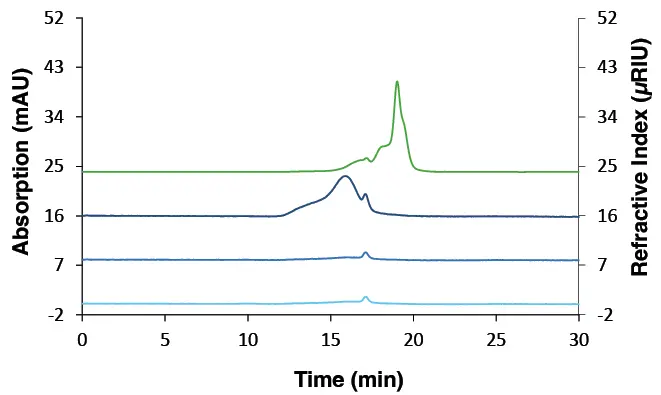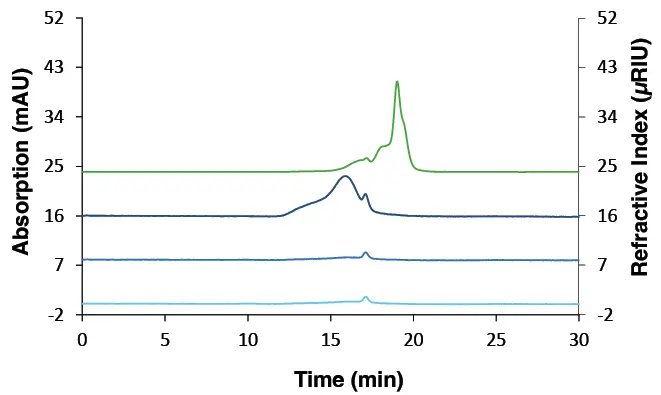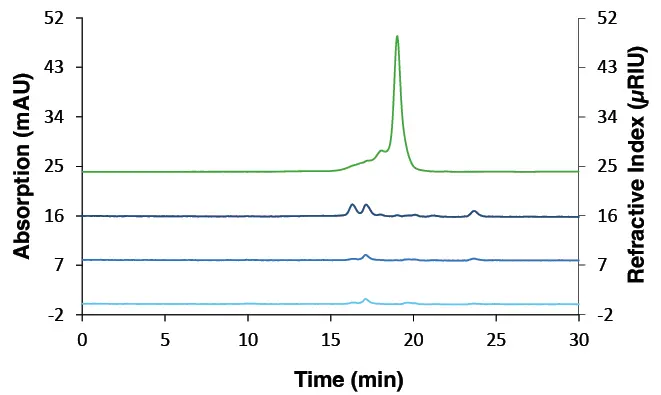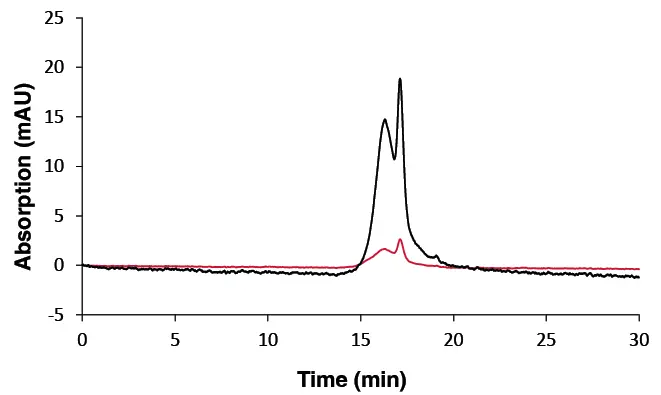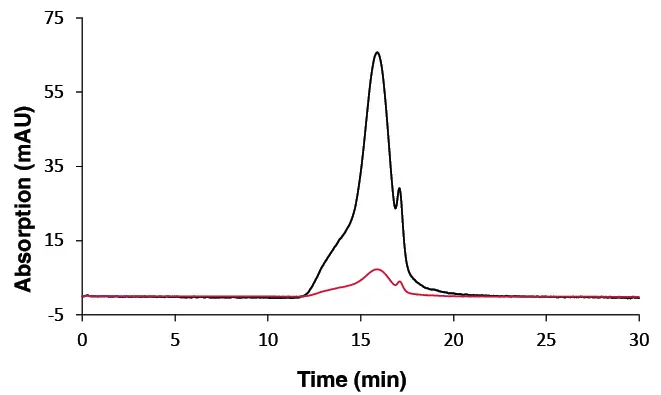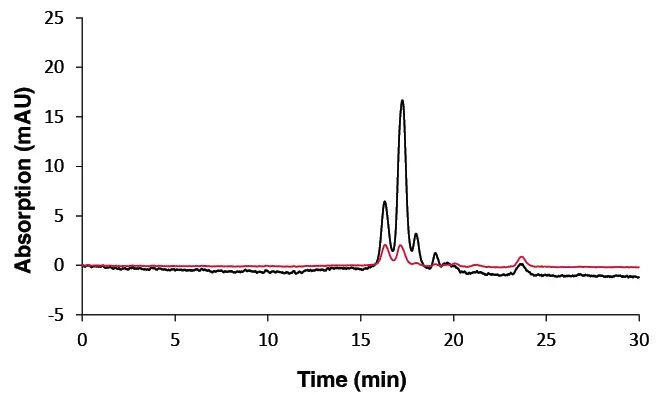
Science with Passion
Application No.: VFD0195 Version 1 11/2025
SEC for fingerprint analysis of gummy candies – ensuring product quality and process control
J. Wesolowski, J. Kramer, K. Folmert, U. Krop; wesolowski@knauer.net
KNAUER Wissenschaftliche Geräte GmbH, Hegauer Weg 38, 14163 Berlin
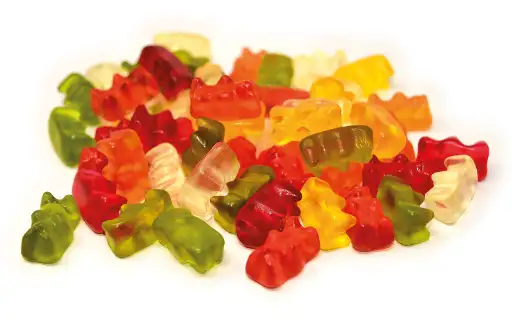
Summary
Size Exclusion Chromatography (SEC) was applied to gummy candies to evaluate its potential for product quality and process control. Different gummy candies were analysed, containing gelling agents such as porcine and bovine gelatin as well as plant-based alternatives like pectin, using an AZURA® SEC system, equipped with a diode array detector (DAD) and a refractive index detector (RID). The study combined two sample preparation strategies with a comparison of different columns, all in entirely aqueous buffer. The results demonstrate that fingerprinting by SEC provides a powerful tool for product quality and process control, enabling rapid quality control, detection of production errors, verification of batch consistency, differentiation between products and manufacturers, and monitoring of storage-related changes to assess shelf life and stability. The method also enables a semi-quantitative estimation of low-molecular-weight components, such as sugars and organic acids, based on peak height.
Introduction
Gummy candies are one of the most widely consumed confectionery products globally, with consumption reaching over 3.2 million tons just in 2023 [1]. Their popularity is attributed not only to their diverse flavour profiles, but also to their characteristic texture, which is determined by the used gelling agent [2] [3]. Typical formulations contain high levels of sugars, organic acids, colourings and flavourings, combined with a gelling agent. Traditionally, gelatin of animal origin has been used, but plant-based alternatives such as pectin are becoming increasingly popular [3]. Gelatin imparts the characteristic chewiness and elasticity, whereas pectin produces a noticeably firmer structure. In addition, the gel strength of these gelling agents depends on factors such as their concentration and the composition of other ingredients [2] [3]. Consequently, even minor variations in the manufacturing process can significantly affect texture, elasticity, transparency, and taste [2] [4]. For this reason, reliable and reproducible monitoring of these ingredients is essential for the food industry. In this context, SEC represents a powerful analytical approach for the characterization of gummy candies.
SEC separates molecules according to their hydro-dynamic size/radius, generating a highly reproducible chromatographic profile, so called “fingerprint” for each formulation of gummy candy. This fingerprint enables rapid quality control by detecting production errors and verifying batch consistency. It can clearly differentiate between manufacturers, as well as between products from the same manufacturer. Furthermore, it allows monitoring of time-dependent changes during storage, providing insights into product shelf life and stability.
SEC is also well suited for the characterization of polymers and biopolymers, including the gelling agents found in gummy candies, such as gelatin an animal-derived protein from collagen and pectin, a plant-derived polysaccharide. By coupling SEC with special detectors and applying appropriate calibration, the method can be extended to provide quantitative information on the molecular weight and molecular weight distribution of gelling agents such as gelatin [2] [4]. This is relevant not only for confectionery analysis but also for the pharmaceutical industry, for example in the quality assessment of hard and soft gelatin capsules, coatings, and other drug-delivery systems [4].
Sample Preparation
Tab. 1 Used samples and its ingredients
Number | Ingredients | |
1 | 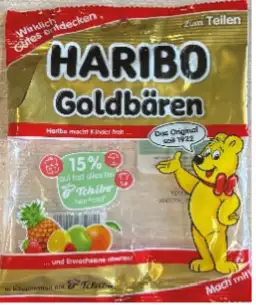 | Sugar; glucose syrup; gelatin (porcine); dextrose; fruit juice from fruit juice concentrate: apple, raspberry, strawberry, orange, lemon, pineapple; acidifier: citric acid; fruit and plant concentrates: safflower, spirulina, apple, elderberry, orange, blackcurrant, kiwi, lemon, aronia, mango, passion fruit, grape; flavoring; sunflower oil; elderberry extract; glazing agents: white and yellow beeswax |
2 |  | Sugar; glucose syrup; gelatin (bovine); dextrose; fruit juice from fruit juice concentrate: apple, raspberry, strawberry, orange, lemon, pineapple; acidifier: citric acid; fruit and plant concentrates: safflower, spirulina, apple, elderberry, orange, blackcurrant, kiwi, lemon, aronia, mango, passion fruit, grape; flavoring; sunflower oil; elderberry extract; glazing agents: white and yellow beeswax |
3 |  | Sugar; glucose syrup; maltodextrin, 6 % skimmed milk yogurt powder; gelling agents: pectins; acidity regulators: sodium-potassium tartrate, potassium citrate; acidifiers: citric acid, lactic acid, natural flavorings; coloring fruit and plant concentrates: carrot, black carrot, apple, lemon, red cabbage, blueberry; sunflower oil; glazing agents: carnauba wax |
4 | 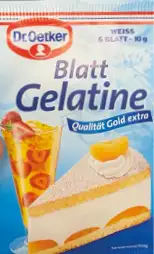 | Gelatin |
5 |  | Maltodextrin, 38.5 % gelatin (bovine) |
6 |  | Apple pectin |
7 | 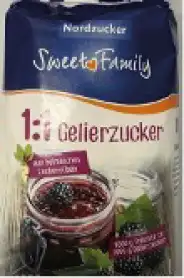 | Sugar; acidifier: citric acid; gelling agent: pectin; fully hydrogenated sunflower oil |
The list of all the samples that were used, along with the ingredients they contain, can be found in Tab. 1. Samples 1 to 4 were cut into small pieces to increase their surface area and make them easier to dissolve. Care was taken not to mince the samples in a grinder, to prevent mechanical degradation of the molecular chains. The pieces were dissolved in phosphate-buffered saline (PBS, pH 7.4, from Sigma-Aldrich), which was the same as the mobile phase of the selected SEC system. PBS was chosen because its ionic strength minimizes non size exclusion interactions and stabilizes the polymer solution by preventing ionic aggregation [4]. A solution of 1 % (w/v) was prepared, as higher concentrations were avoided to prevent column overloading and ensure complete dissolution. Two replicates (A and B) were prepared for each sample, which were then left standing overnight on a shaker at low shaking frequency (Fig. 1). The gummy candies fully dissolve overnight.
The following day, all replicates labeled A were heated at 40 °C for 5 minutes under stirring and subsequently allowed to cool down, while replicates B were left untreated. Both sets of replicates were then filtered through a 0.45 µm cellulose acetate (CA) filter to prevent column clogging and to ensure reproducible, clean chromatograms. Highly concentrated samples, such as sample 4, 5 and 6, were pre-diluted with mobile phase in a ratio of 1:10 to avoid column overloading. Single reference standards (ethylene glycol, citric acid, lactose, glucose (dextrose), fructose, sucrose (sugar), maltodextrin, lactic acid, malic acid, sodium-potassium tartrate, potassium citrate) were prepared at 1 mg/mL in PBS and filtered through a 0.45 µm CA filter. A PBS blank was prepared and filtered in the same way because treating the blank identically to the samples is essential to account for all systematic effects.
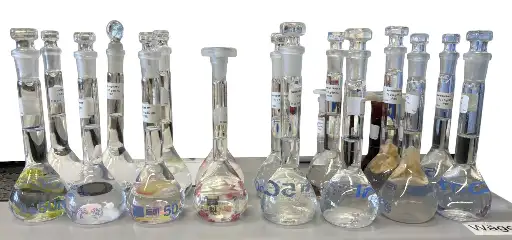
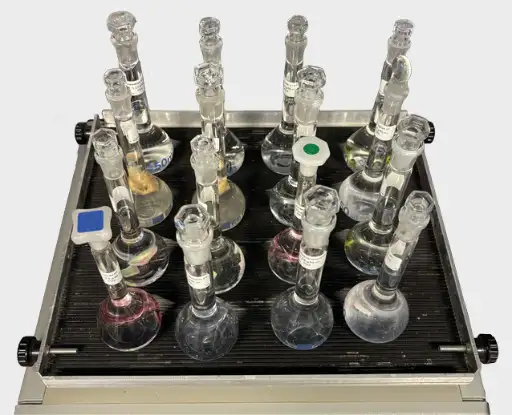
Fig. 1 Sample preparation for SEC analyses.
Results
The influence of temperature during sample preparation was investigated. After overnight shaking, the samples were divided into two groups: samples A were heated under stirring at 40 °C for 5 minutes, then cooled and filtered, while samples B were filtered directly without prior heating. Both procedures were applied to each gummy candy, and the resulting chromatograms were subsequently analysed. The results showed that an effect of temperature was particularly observed in gummy candies containing gelatin as the gelling agent (Fig. 2 and Fig. 3). The non-heated samples (B) provided more reliable replicate measurements, whereas the heated samples (A) showed lower reproducibility and a degradation over time. In contrast, the vegan gummy candy containing pectin as the gelling agent showed no significant differences between heated and non-heated samples (Fig. 4 and Fig. 5). Based on these results, only the non-heated samples (B) were analysed further, except where no non-heated measurements were available. In such cases, the corresponding data are indicated by an asterisk (*). These results demonstrate that the SEC technique can be used to reliably investigate the effects of temperature on polymers and biopolymers [5] [6].
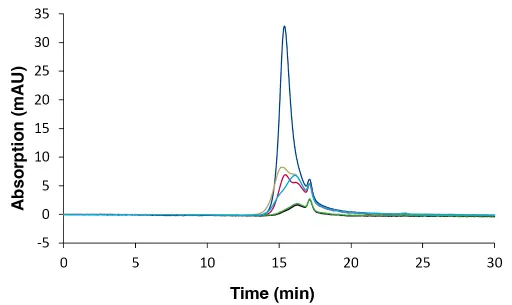
Fig. 2 Overlay chromatograms of sample 1 measured with DAD 230 nm, 20 µL and column set B. Dark blue: 1st replicate A; red: 2nd replicate A; gold: 3rd replicate A; light blue: 4th replicate A; green: 1st replicate B; black: 2nd replicate B.
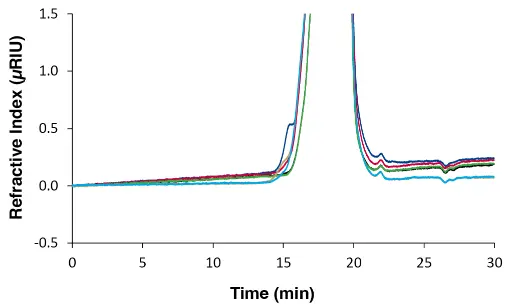
Fig. 3 Overlay chromatograms of sample 1 measured with RID, 20 µL and column set B. Dark blue: 1st replicate A; red: 2nd replicate A; gold: 3rd replicate A; light blue: 4th replicate A; green: 1st replicate B; black: 2nd replicate B.

Fig. 4 Overlay chromatograms of sample 3 measured with DAD, 20 µL and column set B. Red: 2nd replicate A; black: 1st replicate B; green: 2nd replicate B. Data for replicate A1 is not available.

Fig. 5 Overlay chromatograms of sample 3 measured with RID, 20 µL and column set B. Dark blue: 1st replicate A; red: 2nd replicate A; black: 1st replicate B; green: 2nd replicate B.
During the experiment, two unknown peaks were observed in the RID trace. These were identified as system peaks (SPs). This is a common phenomenon in liquid chromatography, even when a pure mobile phase is injected. To exclude these peaks from the data analysis, they must first be identified. Overlaying a blank injection with the sample injection enables the SPs to be identified (Fig. 6).
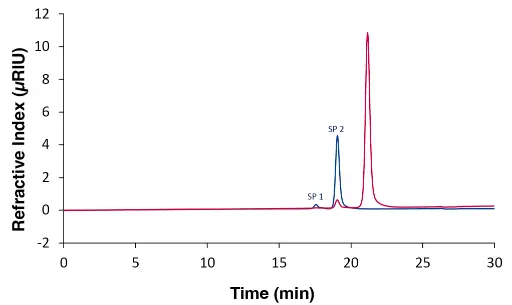
Fig. 6 Overlay chromatograms measured with RID, 20 µL and column set B. Dark blue: blank; red: ethylene glycol.
It is important to mention that the areas of SPs strongly depend on the analytes themselves. For more details and a clearer understanding of system peaks, please refer to the technical note
All measurements were performed either with a AppliChrom® Multipore SuperOH-P column (column A) or with a combination of a AppliChrom® SuperOH-P 350 column coupled to a AppliChrom® SuperOH-P 150 column (column set B). Both approaches cover the same separation range of 100 to 1 000 000 Da, but coupling the columns provides twice the separation length. Consequently, an improved resolution was expected, and the results confirmed this assumption. Fig. 7 shows the chromatograms of porcine and bovine gelatin measured on both column sets with a DAD at 230 nm. Only the DAD trace was shown, since the presence of maltodextrin from sample 5 (Tab. 1) in the RID signal would interfere with the interpretation of the gelatin peaks. Furthermore, the DAD provides a more selective response to gelatin due to its UV activity, resulting in a clearer and more reliable evaluation. As expected, column set B provided better separation. Subsequently, sample measurements taken using column set B produced a more detailed fingerprint.
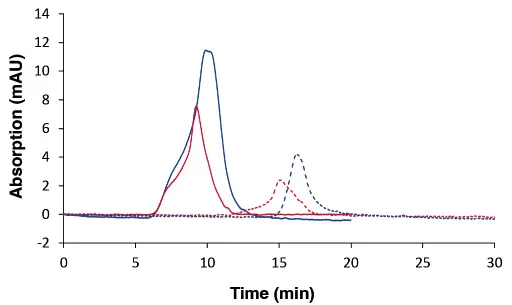
Fig. 7 Overlay chromatograms measured with DAD at 230 nm, 20 µL. Dark blue: sample 4; red: sample 5; solid line: sample* measured with column A; dotted line: sample measured with column set B.

Fig. 8 Zoom overlay chromatograms measured with RID, 20 µL and column set B. Black: sample 3; turquoise: sample 6 diluted 1:10; dark green: sample 7; dark blue: maltodextrin; pink: sodium potassium tartrate; yellow: potassium citrate; red: citric acid; purple: lactic acid; beige: lactose; orange: sucrose; green: glucose; grey: blank.
In general, SEC is considered to be a purely size-based separation technique. In practice, however, no column is completely interaction-free [7]. Both small molecules and larger molecules, such as polymers and biopolymers, can be influenced by secondary effects, which result in a mixed-mode mechanism [4] [7]. Consequently, elution depends not only on hydrodynamic volume but also on enthalpic interactions between the analytes and the stationary phase [4] [7]. While such interactions should ideally be minimized when determining polymer molar masses, they can be beneficial for low-molecular-weight substances, as they facilitate their identification and quantification [7]. To accurately identify peaks and interpret molecular fingerprints for use in product quality and process control, single standards selected based on the ingredient lists of the gummy candies were measured. By assigning as many peaks as possible, the fingerprints reliably reflect the composition of each sample (Fig. 8).
Fig. 9 shows the fingerprints of the three gummy candy samples. Each chromatogram includes the RID signal and the DAD traces recorded at three different wavelengths. The fingerprints at two of the DAD wavelengths appear very similar and provide only limited differentiation. Effective, distinguishable fingerprints are therefore obtained solely from the RID signal and the DAD trace at 230 nm. Zooming in on the chromatograms further highlights the differences in the RID signal (Fig. 10).
Fig. 9 Sample fingerprints measured with DAD and RID, 20 µL and column set B. Left: sample 1; middle: sample 2; right: sample 3. Green: RID; dark blue: DAD 230 nm; blue: DAD 254 nm; light blue: DAD 260 nm.
This highlights the importance of selecting the right wavelengths to clearly reveal differences between samples. For example, using a wavelength of 210 nm can further enhance the visibility of differences (Fig. 11). The reconstruction of a chromatogram at a different wavelength, here 210 nm, is thereby possible through the use of a DAD.
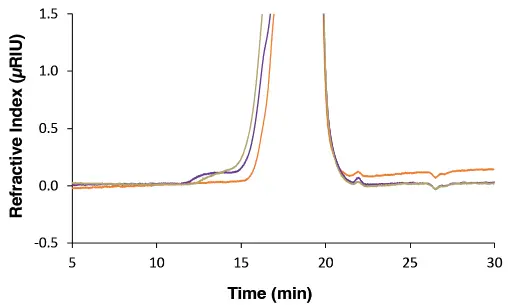
Fig. 10 Zoom sample fingerprints measured with RID, 20 µL and column set B. Orange: sample 1; gold: sample 2; purple: sample 3.
Fig. 11 Sample fingerprints measured with DAD, 20 µL and column set B. Left: sample 1; middle: sample 2; right: sample 3. Red: DAD 230 nm; black: DAD 210 nm.
Overall, the columns, used in combination with the AZURA® SEC system, provide good separation of the substances, producing unique and reproducible fingerprints for each gummy candy. These fingerprints enable rapid comparison between products and support the monitoring of product consistency and process performance. For reliable results it is important to maintain consistent sample preparation and identical chromatography conditions. To further improve the reliability of the method, a flow marker can be used to eliminate system related errors. This marker allows the detection of flow rate fluctuations during the measurement, which could otherwise cause shifts in retention times. Such shifts may affect peak assignment and thus the interpretation of the data. By using a flow marker, these fluctuations can be corrected, ensuring consistent and reliable results. For more information about the flow marker, its function, and its use in SEC, see
Product comparison for different gelatin origins
Using the correct source of gelatin is critical for halal products, as the concept of halal is a significant religious commitment that influences the consumption habits of Muslims [8]. Religious guidelines often restrict certain foods, for example, pork is forbidden in both Islam and Judaism, while beef and pork are restricted in Hinduism and Buddhism, making the source of animal-derived ingredients crucial [8]. Compliance with these requirements is essential to meet consumer expectations and religious guidelines [8].
Sample 1 and sample 2 have identical ingredient lists, differing only in the gelatin source (Tab. 1). Sample 1 contains porcine gelatin, whereas sample 2 contains bovine gelatin, resulting in a halal compliant product. An SEC analysis was performed on both samples, as well as on reference gelatin samples 4 and 5. Thereby clear differences were observed in the gelatin peak region. Comparing the fingerprints of samples 1 and 2 shows that sample 1's gelatin peak region matches that of porcine gelatin (sample 4), while sample 2's corresponds to bovine gelatin (sample 5) (Fig. 12 and Fig. 13). These results confirm that the gelatin source differs between the two products, consistent with labeling and halal requirements. Furthermore, this demonstrates that SEC fingerprints can be used effectively for product comparisons and quality control, for example, of the gelatin source.

Fig. 12 Overlay chromatograms measured with DAD at 230 nm, 20 µL and column set B. Solid dark blue line: sample 1; solid red line: sample 2; dotted dark blue line: sample 4; dotted red line: sample 5.

Fig. 13 Overlay chromatograms measured with RID, 20 µL and column set B. Solid dark blue line: sample 1; solid red line: sample 2; dotted dark blue line: sample 4; dotted red line: sample 5.
SEC derived fingerprints enable not only the comparison of polymers and biopolymers, such as gelatin, but also the semi-quantitative evaluation of low-molecular-weight components, including sugars. While not substitute for fully validated HPLC methods, this approach provides a rapid and reliable tool for preliminary screening and comparative analysis, supporting routine quality control and ensuring product consistency. In Fig. 14, the RID signal of a sucrose standard is shown alongside the RID fingerprints of sample 1 and 7. As expected, sample 7 shows a significantly higher sucrose peak than sample 1, reflecting differences in sugar content. The RID detector is particularly valuable in this context, as sugars are UV-inactive and cannot be reliably detected by DAD.
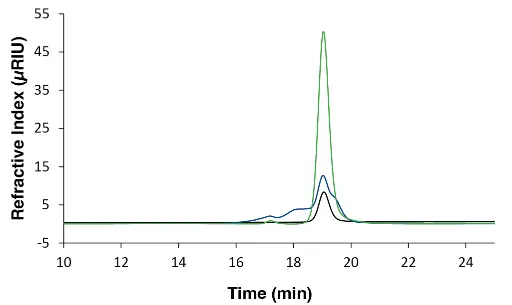
Fig. 14 Zoom overlay chromatograms measured with RID, 20 µL and column set B. Black: sucrose; blue: sample 1; green: sample 7.
Conclusion
It was demonstrated that SEC can be used as a reliable and versatile chromatographic technique for product quality and process control for various gummy candies. This study involved investigating sample preparation procedures and testing different columns. Characteristic chromatographic fingerprints were thereby generated, enabling the identification of production deviations, verification of batch consistency, differentiation between products and manufacturers, and monitoring of storage-related changes using UV and RI detection. Additionally, the method enables the semi-quantitative estimation of low-molecular-weight components, such as sugars. Moreover, this approach can be expanded and adapted for use with other suitable products.
Material and Methods
Tab. 2 Method parameter.
Parameter | Value |
Flow rate | 1 mL/min |
Isocratic | H2O/PBS-Buffer (pH 7.4) |
Column temperature | 30 °C |
Injection volume | 20 µL |
Injection mode | Partial loop |
Wavelenght | 230/254/260 nm |
Data rate | 10 Hz |
Time constant | 0.1 s |
Time | Column A: 20 min |
Column set B: 30 min |
Tab. 3 System configuration.
Instrument | Description | Article No. |
Eluent tray | AZURA® Eluent Tray E 2.1L | |
Pump | AZURA® P 6.1L Pump LPG, Stainless Steel, 10 mL/min | |
Detector | AZURA® DAD 2.1L Diode Array Detector, without Flow Cell, 190 - 700 nm | |
AZURA® RID 2.1L Refractive Index Detector, with Flow Cell, up to 10 mL/min | ||
Autosampler | AZURA® AS 6.1L analytical Autosampler up to 1240 bar, without cool/heat option | |
Thermostat | AZURA® CT 2.1 Column Thermostat for up to 8 HPLC columns with temperature range between 5 - 85 °C | |
Column coupling | AppliChrom® SuperOH-P-150, 7 μm, 300 x 8 mm SEC Column, Separation range 100 - 5 000 Da | |
AppliChrom® SuperOH-P-350, 10 μm, 300 x 8 mm SEC Column, Separation range 2 500 - 1 000 000 Da | ||
AppliChrom® SuperOH-P-Multipore, 7 µm, 300 x 8 mm SEC Column, Separation Range 100 - 1 000 000 Da | ||
Capillaries | AZURA® Analytical MarvelXACTTM StartUp kit for HPLC Set of capillaries, adapters and connectors | |
Software | ClarityChrom® 9.1.0 station single instrument license one time base | |
ClarityChrom® 9.1.0 PDA license for PDA data processing | ||
ClarityChrom® 9.1.0 GPC license for GPC data processing |

Fig. 15 SEC system setup.
References
[1] (2025) Jelly Candies (Gummies) Market Size, Share, Growth, and Industry Analysis, By Type (Sugar-Based Gummies (SBG), Sugar-Free Gummies (SFG)), By Application (Supermarkets and Hypermarkets, Convenience Stores, Specialist Retailers, Online Retailers), Regional Insights and Forecast to 2033. https://www.marketgrowthreports.com/market-reports/jelly-candies-gummies-market-111677 (Last access: 25.09.2025).
[2] Burey P., Bhandari B., Rutgers R. P. G., Halley P. J. & Torley P. J. (2010). Confectionery Gels: A Review on Formulation, Rheological and Structural Aspects. International Journal Of Food Properties, Vol. 12 (1), 176 - 210.
[3] Tiwari D. & Rastogi M. (2024). Gummy Jellies: Properties and Advancements. International Journal of Plant Biotechnology, Vol. 10 (2), 19 - 32.
[4] Crawshaw B., Herrick D. Z., Gao W., Maziarz E. P. & Liu X. M. (2018). Separation and Characterization of Gelatins Using Aqueous Gel Permeation Chromatography with Advanced Detection Systems. ACS Symposium Series of Recent Progress in Separation of Macromolecules and Particulates, Vol. 1281 (4), 51 - 74.
[5] Tromp R. H., Grotenhuis E. ten & Olieman C. (2002). Self-aggregation of gelatine above the gelling temperature analysed by SEC-MALLS. Food Hydrocolloids, Vol. 16 (3), 235 - 239.
[6] Segtan V. H. & Isaksson T. (2004). Temperature, sample and time dependent structural characteristics of gelatine gels studied by near infrared spectroscopy. Food Hydrocolloids, Vol. 18 (1), 1 - 11.
[7] Held D. (2017). Tips & Tricks GPC/SEC: Quantify and Get More Than Molar Mass Averages. https://www.chromatographyonline.com/view/tips-tricks-gpcsec-quantify-and-get-more-molar-mass-averages-0 (Last access: 25.09.2025).
[8] Hanzaee K. H. & Ramezani M. R. (2011). Intention To Halal Products In The World Markets. Interdisciplinary Journal Of Research in Business, Vol. 1 (5), 1 - 7.
Application details
|
Method |
GPC/SEC |
|
Mode |
GPC/SEC |
|
Substances |
Apple pectin, malic acid, bovine gelatin, citric acid, dextrose (glucose), ethylene glycol, fructose, lactic acid, lactose, maltodextrin, pork gelatin, potassium citrate, sodium potassium tartrate, sucrose (sugar) |
|
CAS number |
9000-69-5, 6915-15-7, 9000-70-8, 77-92-9, 50-99-7, 107-21-1, 57-48-7, 50-21-5, 63-42-3, 9050-36-6, 9000-70-8, 306-70-3, 7785-14-6, 57-50-1 |
|
Version |
Application No.: VFD0195 | Version 1 11/2025 | ©KNAUER Wissenschaftliche Geräte GmbH |



